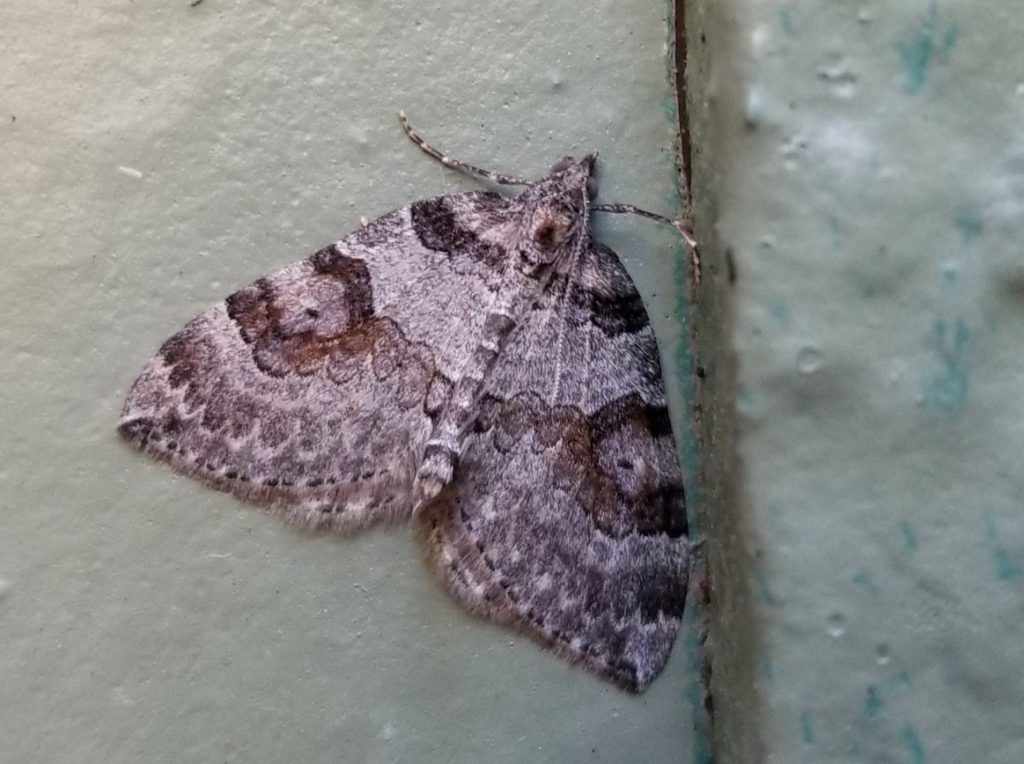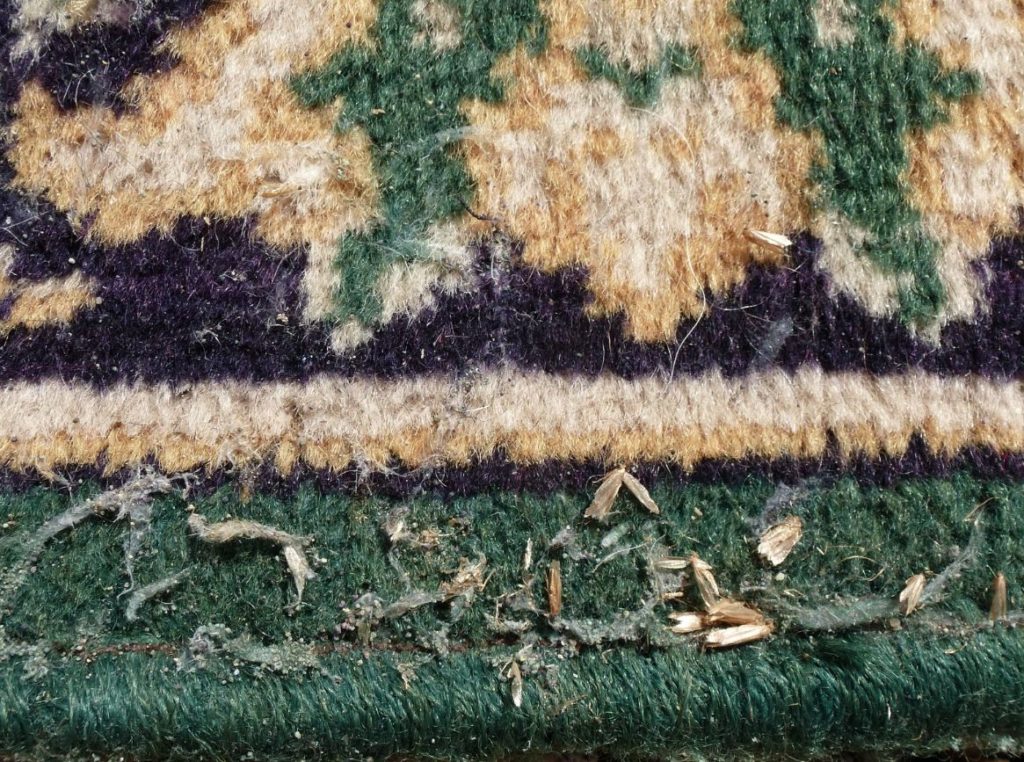
What are the different types of moths that can invade your home and how do you get rid of them? From DIY solutions to professional extermination services, if r carpets are being invaded by carpet moth larvae or adult moths, we’ve got you covered!
What Are Carpet Moths And What Do They Look Like?
There are several types of carpet moths, but most resemble small, brown moths. Carpet moth larvae are commonly white or light-colored with a darker head and can be up to 1 inch long. They are typically found feeding on wool, silk, hair, and other natural fibers.
Both adult carpet moths and their larvae can cause damage to your carpets and other fabric items in your home. The larvae feed on the fibers, while the adults lay eggs in the fabric. If you have a carpet moth infestation, you may notice small holes in your carpets or other fabrics.
The Different Types Of Moths That Can Invade Your Home
There are many different types of moths that can invade your home. Some common examples include:
Webbing clothes moth
The caterpillars of this moth are considered a serious pest, as they can derive nourishment from clothing – in particular wool, but many other natural fibers – and also, like most related species, from stored food. They’re distinguishable from other types of moths by the weblike material they weave to make their nests.
This moth prefers moist conditions, although low humidity will merely slow development. Webbing Clothes Moths are small moths whose adults grow to between 1 and 2 cm in length. Their eggs are tiny, most being under 1 mm long and barely visible. Unlike many other moths, which are drawn to light, Clothes Moths seem to prefer dim or dark areas.
Clothes moths lay their eggs on natural materials like wool, cashmere, silk, and fur. The eggs hatch into caterpillars, which then eat away at the fabric. Eventually, the caterpillars spin cocoons and become adult moths.
If you have a clothes moth infestation, you can get rid of them by:
- Putting your clothes in the freezer for a few days;
- Using an insecticide; or
- Removing all food sources (e.g., pet hair, lint) from your home.
Case-bearing clothes moth
The adult moth is a pale silvery grey-brown with dark spots, and approximately 7mm long. The larva makes a portable case for itself out of wool and other fibers. in heated buildings it can have two or more generations. The larval stage lasts up to 3 months after which time they spin a cocoon to pupate in. The discarded cocoons look like small grains of rice. The larvae feed on wool, fur, feathers and hair.
Indian meal moth
a very common household pest, feeding principally on stored food products. In fact, it has been called the most important pest of stored products commonly found in American homes or grocery stores. The larvae are general feeders and can be found in grain products, seeds, dried fruit, dog food, and spices. The larvae are surface feeders. Most of the “damage” to stored products occurs when the larvae spin massive amounts of silk that accumulate fecal pellets, cast skins, and egg shells in food products. The damage to stored products due to this contamination exceeds the amount of food eaten by the insects.
Each type of moth will have its own specific set of preferences when it comes to food and environment. Some moths prefer to feed on natural fibers such as wool or cotton, while others prefer to feed on processed foods such as grains or cereals. And some moths prefer to live in warm, dry environments, while others prefer cooler, damper environments.
So it’s important to be aware of the specific preferences of each type of moth so you can take steps to prevent them from invading your home. For example, you can reduce your chances of a carpet moth infestation by storing your wool and other natural fiber items in airtight containers. You can also reduce your chances of an Indian meal moth infestation by keeping your food storage areas clean and free of spills or crumbs.
How Do Carpet Moths Get Into Your House?
There are a few ways that carpet moths can get into your house. One way is through an open door or window. Moths can also come in through cracks in the door, windows, or foundation of your house. They can also come in through the vents or chimney. They might come in by hitching a ride on clothing or furniture that you bring into your house.
Once they’re inside, carpet moths will typically stay in the area where they came in. They’ll start to lay eggs and their larvae will begin to feed on the fibers in your carpet or clothing.
Assess The Intensity Of Your Carpet Moth Infestation
The first step in assessing the intensity of your carpet moth infestation is to determine the level of damage being done. Look for holes in your carpets, and pull back any rugs or mats to check for damage underneath. If you see evidence of carpet moth larvae or cocoons, this means that the infestation is already quite severe.
If you don’t see any obvious damage, try sprinkling some flour on the floor and checking for any signs of movement; if there are moths present, you’ll see them crawling around in the flour. You can also place a rolled-up newspaper near an affected area and watch for moths flying toward it – this will help you to determine whether or not they’re active at night.

Once you’ve determined the level of damage, you can begin to take steps to get rid of the carpet moths.
Eliminating Carpet Moth Eggs and Carpet Moth Larvae
There are a few things that you can do to help eliminate carpet moth eggs and larvae:
- Vacuum your carpets frequently, especially in areas that are known to be popular with carpet moths.
- Remove any affected carpets from your home and dispose of them properly.
- Kill existing larvae.
- Sprinkle diatomaceous earth around your home to help deter future infestations.
These methods will help to reduce the number of larvae and eggs that are present in your home, but they won’t completely eliminate them. For that, you’ll need to take more serious measures.
Cleaning Out Where Carpet Moths Live
Cleaning out where carpet moths live is very important in preventing an infestation. Not only do they live in carpets, but they can also be found in furniture, rugs, and other areas where fabric is present.
The first step in cleaning out where carpet moths live is to vacuum the entire area thoroughly. This will help remove any eggs or larvae that may be present. Be sure to dispose of the vacuum bag immediately after vacuuming and do not reuse it; this will help prevent any re-infestation from occurring.
Then clean all of your fabrics with a detergent that’s specifically designed for killing fabric pests. Be sure to read the instructions carefully so that you know how long to leave the detergent on the surface before rinsing it off.
After you’ve cleaned all of your fabric surfaces, you’ll want to take measures to prevent the carpet moths from returning. This can be done by using moth traps or by regularly vacuuming and performing a good carpet cleaning in your home.
Contact a professional exterminator like Patriot Property Restoration, LLC to take care of the problem for you. We will treat your home to help prevent any future infestations.
Carpet moths can be a real nuisance, but with the proper treatment, they can be eliminated. Be sure to take the necessary steps to get rid of them before they cause any more damage to your home.
Natural Moth-Repellent Remedies
There are a few natural moth-repellent remedies that you can try to help discourage carpet moths from infesting your home.
Lavender Oil
One is to make a spray with lavender oil. Carpet moths are known to be deterred by essential oils with lavender being the most commonly used. To make the lavender oil spray, mix together 10 drops of lavender oil and 2 cups of water in a spray bottle. Shake it well and then use it to mist any areas you think might be attractive to carpet moths.
Vinegar And Water
You may also want to consider making a spray with vinegar and water. To make the vinegar and water spray, mix together 1 cup of vinegar and 1 cup of water in a spray bottle. Again, shake it well and then use it to mist the areas of concern.
Cedar Wood And Apple Cider Vinegar
Finally, we recommend trying a mix of cedar wood chips and apple cider vinegar. To make the cedar wood chips and apple cider vinegar spray, put 1 cup of cedar chips in a bowl and pour 1 cup of apple cider vinegar over them. Let them soak for 24 hours and then strain out the cedar chips. Pour the mixture into a spray bottle and use it to mist any areas you might be worried about.
All of these sprays work by repelling moths, and they are all safe to use around pets and children. Keep in mind, these sprays do not kill moths.
When To Call In A Professional Exterminator
The best time to call in a professional exterminator for carpet moths will depend on the severity of the infestation and the damage they are causing. Call in a professional exterminator if you see adult carpet moths flying around the home or if you find eggs or larvae on your carpets. If you’re not sure whether or not you have a carpet moth infestation, a professional exterminator like Patriot Property Restoration will be able to tell you for sure and help you get rid of them for good.
Do You Have Moths In Your Ocean County, NJ Home or Business?
Call 609-549-3058 Or Contact Us Now
Frequently Asked Questions
Q: Are tapestry moths and carpet beetles the same thing?
No, they are not the same thing. Tapestry moths are a type of moth, while carpet beetles are a type of beetle. They both feed on fabrics, but tapestry moths prefer natural fibers like wool and silk, while carpet beetles prefer man-made fibers like nylon and acrylic.




